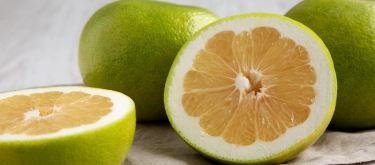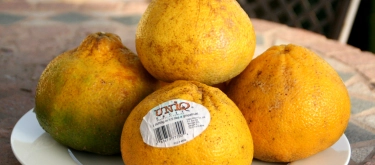Grapefruit: Taste, Uses, Benefits and Harm
Grapefruit is a unique citrus fruit known for its refreshing and complex flavor profile, combining sweet, sour, and slightly bitter notes. This globally popular fruit is valued not only for its distinctive taste but also for its high content of vitamins and antioxidants. Grapefruit is widely enjoyed in juices, salads, and various culinary applications. This article explores the flavor characteristics of grapefruit, its culinary uses, health benefits, and tips for selecting and storing it.

Primary Flavor Characteristics
Grapefruit has a layered flavor, balancing sweetness and acidity with a hint of bitterness. The taste can vary depending on the variety and ripeness: some types are sweeter, while others are more sour and bitter. Overall, grapefruit has a refreshing, slightly tangy flavor that stands out among other citrus fruits.
Aromatic and Taste Nuances
Grapefruit's aroma is a blend of bright citrus notes with a faint, distinctive bitterness. When cut open, grapefruit releases a strong, fresh scent that enhances dishes with a citrusy flair. This balance of sourness and slight bitterness makes it a unique ingredient in both sweet and savory culinary creations.
Scientific Description of Taste and Aroma
- Aroma: Strong, citrusy, with a fresh note and a hint of bitterness.
- Taste: Sweet and sour with characteristic bitterness.
- Texture: Juicy and crisp, with pulp that easily separates into segments.
In-Depth Flavor Analysis of Grapefruit
Underlying Flavor Notes
Grapefruit's flavor evolves depending on its ripeness and how it is used in dishes:
- Citrus Sweetness: Some varieties, particularly pink and red grapefruits, have a natural sweetness that balances their sour notes.
- Bitterness: The distinct bitterness adds depth, setting grapefruit apart from other citrus fruits.
- Refreshing Acidity: Grapefruit's sourness gives it a refreshing, tangy quality that works well in drinks and light dishes.
Impact of Ripeness on Flavor
- Under-ripe Grapefruit: Often more bitter and acidic, with less sweetness, making it sharper in taste.
- Fully Ripe Grapefruit: Juicy, with a balanced sweetness and acidity, and a more mellow bitterness.
Textural Qualities
Grapefruit is known for its juicy, succulent flesh that is both firm and tender, providing a satisfying bite. The texture makes it ideal for juicing and adding to salads.
Culinary Uses of Grapefruit
Primary Uses
- Fresh Grapefruit: Often enjoyed fresh, halved, and sprinkled with a little sugar or honey to offset the bitterness.
- Salads: Grapefruit adds a bright citrus element to salads, pairing well with greens, avocado, and seafood.
- Juices and Beverages: Grapefruit juice is popular both on its own and in cocktails, offering a refreshing and tangy flavor.
- Sauces and Marinades: Grapefruit works well in marinades for chicken, fish, and pork, adding a balance of sweetness and acidity.
- Desserts: Grapefruit can be used in sorbets, fruit salads, and tarts, where its unique flavor complements sweet ingredients.
Ideal Pairings for Grapefruit
- Herbs: Basil and mint enhance grapefruit's freshness.
- Seafood: Shrimp and oysters pair excellently with grapefruit, as its acidity complements their flavors.
- Sweet Fruits: Berries and tropical fruits add sweetness that balances grapefruit's bitterness.
- Spices: Ginger and cinnamon create a warm contrast with grapefruit’s refreshing acidity.
Health Benefits of Grapefruit
Key Nutrients and Benefits
- Vitamin C: Grapefruit is an excellent source of vitamin C, supporting immunity and skin health.
- Antioxidants: Rich in antioxidants, grapefruit helps reduce inflammation and protect cells from damage.
- Potassium: This mineral helps regulate blood pressure and supports heart health.
- Fiber: High in dietary fiber, grapefruit aids in digestion and helps stabilize blood sugar levels.
- Flavonoids: Grapefruit contains flavonoids with antioxidant and anti-inflammatory properties.
Potential Precautions
- Medication Interactions: Grapefruit can interact with certain medications, affecting their effectiveness. It’s important to consult a doctor if you’re taking medications.
- Acidity: Grapefruit’s acidity may cause discomfort for people with sensitive stomachs, so moderate consumption is recommended.

Tips for Choosing and Storing Grapefruit
How to Choose Quality Grapefruit
- Firmness and Weight: Look for firm, heavy grapefruits with smooth skin, indicating high juice content.
- Skin Color: Ripe grapefruits have a rich color—pink to red varieties are typically sweeter.
- Aroma: A ripe grapefruit will have a pleasant, fresh citrus scent.
Storage Recommendations
- At Room Temperature: Grapefruit can be kept at room temperature for about a week.
- In the Refrigerator: For longer storage, place grapefruits in the refrigerator, where they can stay fresh for up to two weeks.
- Freezing: Grapefruit juice can be frozen for later use in beverages and recipes.
Fun Facts About Grapefruit
- Accidental Discovery: Grapefruit was discovered by chance in Barbados and is believed to be a natural hybrid of an orange and a pomelo.
- Medication Interactions: Grapefruit is unique among fruits for its interaction with over 85 types of medications.
- Variety of Colors: Grapefruit varieties include pink, red, and white, each with unique flavor and sweetness levels.





